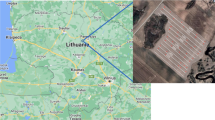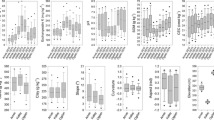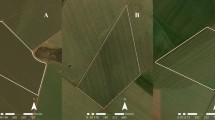Abstract
Germination conditions are determined by hydraulic, thermal and mechanical properties of the soils. In heterogeneous fields, the most favourable seeding depth varies spatially. To investigate the influence of seeding depth on emergence and grain yield of corn, corn was planted in depths of 40, 50, 60, 70, 80 and 90 mm in three experimental years (2006–2008). The apparent soil electrical conductivity was measured with an EM38. The apparent electrical conductivity was used as a proxy for soil texture, top-soil thickness, effective root zone thickness, soil water content and soil structure. The spatial dependencies among emergence, yield and apparent electrical conductivity were considered by including spatial models into the statistical analysis. The results showed significant correlations of the apparent soil electrical conductivity, of the experimental year, and of the seeding depth with the emergence of corn. Deeper planted corn (80 or 90 mm) resulted in more emergence than shallow planted corn (+4.4% in 2006, +1.2% in 2007 and +1.5% in 2008). The emergence decreased with increasing apparent soil electrical conductivity values. The corn grain yield was significantly affected by the soil electrical conductivity, by emergence and by the experimental year. Increasing apparent soil electrical conductivity values were correlated with decreasing yield (from 7.5 to 3.4 Mg ha−1 in 2006, from 10.8 to 5.3 Mg ha−1 in 2007 and from 8.4 to 2.9 Mg ha−1 in 2008). Increasing emergence resulted in increasing yield.






Similar content being viewed by others
References
Akaike, H. (1974). A new look at the statistical model identification. IEEE Transactions on Automatic Control, 19, 716–723.
Aldrich, S., Scott, W., & Leng, E. (1975). Modern corn production (2nd ed.). Champaign: A & L Publications.
Alessi, J., & Power, J. F. (1971). Corn emergence in relation to soil temperature and seeding depth. Agronomy Journal, 63, 717–719.
Becker, R., Chambers, J., & Wilks, A. (1988). The new S language: A programming environment for data analysis and graphics. Monterey: Wadsworth and Brooks/Cole.
Berry, D., & Lindgren, B. (1996). Statistics: Theory and methods. Belmont: Duxbury Press.
Blacklow, W. M. (1972). Influence of temperature on germination and elongation of the radicle and shoot of corn. Crop Science, 12, 647–650.
Buchner, W. (2003). Optimales Bodengefüge sichert Maiserträge (optimum soil structure ensures corn yield). Mais, 31, 120–123.
Buckle, J. A., & Grant, P. M. (1974). Effects of soil temperature on plumule growth and seedling emergence of maize. The Rhodesian Journal of Agricultural Research, 12, 149–161.
Bundestag. (2007). Gesetz zur Schätzung des landwirtschaftlichen Kulturbodens (Federal law of Germany on taxation of agricultural soils). Bundesgesetzblatt I, 3150, 3176.
Bunting, ES. (1978) Agronomic and physiological factors affecting forage maize production. In ES. Bunting, BF. Pain, RH. Phipps, JM. Wilkinson & RE. Gunn (Eds.), Forage Maize production and utilization (pp. 57–85). London: Agricultural Research Council.
Coffman, F. A. (1923). The minimum temperature of germination of seeds. Journal of the American Society of Agronomy, 15, 257–270.
Collis-George, N., & Sands, J. E. (1959). The control of seed germination by moisture as a soil physical property. Australian Journal of Agricultural Research, 10, 628–637.
Corwin, D., & Lesch, S. (2003). Application of soil electrical conductivity to precision agriculture: Theory, principles, and guidelines. Agronomy Journal, 95, 455–471.
Corwin, D., & Lesch, S. (2005). Apparent soil electrical conductivity measurements in agriculture. Computers and Electronics in Agriculture, 46, 11–43.
Corwin, D., Lesch, S., Shouse, P., Soppe, R., & Ayars, J. (2003). Identifying soil properties that influence cotton yield using soil sampling directed by apparent soil electrical conductivity. Agronomy Journal, 95, 352–364.
Crawley, M. (2005). Statistics: An introduction using R. Chichester: Wiley.
Crawley, M. (2007). The R Book. Chichester: Wiley.
Cummins, D. G., & Parks, W. L. (1961). The germination of corn and wheat as affected by various fertilizer salts at different soil temperatures. Soil Science Society of America Proceedings, 25, 47–49.
Dasberg, S., & Mendel, K. (1971). The effect of soil water and aeration on seed germination. Journal of Experimental Botany, 22, 992–998.
Dexter, A. R., & Bird, N. R. A. (2001). Methods for predicting the optimum and the range of soil water contents for tillage based on the water retention curve. Soil and Tillage Research, 57, 203–212.
Erickson, R. O. (1959). Integration of plant growth process. American Naturalist, 93, 225–235.
FAO (1998) World reference base for soil resources. In World soil resource report (84 edn). Rome, Italy: FAO.
Geonics Limited. (1997). Application of electromagnetic methods: Soil salinity. Mississauga, Canada: Geonics Limited.
Geyer, O., & Gwinner, M. (1991). Regional Geology of the State of Baden Württemberg, Germany. Stuttgart, Germany: Schweizerbart.
Grossmann, W. (1976). Geodätische Rechnungen und Abbildungen in der Landesvermessung (geodetic calculations and figures for state land survey). Stuttgart, Germany: Konrad Wittwer.
Gupta, S., Schneider, E., & Swan, J. B. (1988). Planting depth and tillage interactions on corn emergence. Soil Science Society of America Journal, 52, 1122–1127.
Hadas, A. (1970). Factors affecting seed germination under soil moisture stress. The Israel Journal of Agricultural Research, 20, 3–14.
Hadas, A., & Russo, D. (1974). Water uptake by seeds as affected by water stress, capillary conductivity, and seed-soil water contact. Agronomy Journal, 66, 643–647.
Hadas, A., & Stibbe, E. (1973). An analysis of soil water movement towards seedlings prior to emergence. In A. Hadas, D. Swartzendruber, P. E. Rijtema, M. Fuchs, & B. Yaron (Eds.), Physical Aspects of Soil Water and Salts in Ecosystems (4th ed., pp. 97–106). Berlin, Germany: Springer-Verlag.
Hunter, J. R., & Erickson, A. E. (1952). Relation of seed germination to soil moisture tension. Agronomy Journal, 44, 107–109.
Inman, D., Freeland, R., Ammons, J., & Yoder, R. (2002). Soil investigations using electromagnetic induction and ground-penetrating radar in southwest Tennessee. Soil Science Society of America Journal, 66, 206–211.
Itabari, J., Gregory, P., & Jones, R. (1993). Effect of temperature, soil water status and depth of planting on germination and emergence of maize. Experimental Agriculture, 29, 351–364.
King, J., Dampney, P., Lark, M., Mayr, T., & Bradley, R. (2001). Sensing soil spatial variability by electro-magnetic induction (emi): Its potential in precision farming. In G. Grenier & S. Blackmore (Eds.), Proceedings of the 3rd European Conference on Precision Agriculture (pp. 419–424). Montpellier, France: Agro Montpellier.
Kitchen, N., Sudduth, K., & Drummond, S. (1999). Soil electrical conductivity as a crop productivity measure for claypan soils. Journal of Production Agriculture, 12, 607–617.
Knappenberger, T., & Köller, K. (2006) The dynamic variation of seeding depth of corn. In Proceedings of the 8th international conference on precision agriculture and other precision resources management. Minneapolis, USA. CDROM.
Labouriau, L. G. (1978). Seed germination as a thermobiological problem. Radiation and Environmental Biophysics, 15, 345–366.
Lehenbauer, P. A. (1914). Growth of maize seedlings in relation to temperature. Physiological Researches, 1, 247–288.
McNeill, J. D. (1980). Electromagnetic terrain conductivity measurements at low induction numbers. Technical note TN-6. Mississauga, Canada: Geonics Limited.
Miedema, P. (1982). The effects of low temperature on zea mays. Advances in Agronomy, 35, 93–128.
Miltner, R. (2003). Ursachen für schlechten Feldaufgang (reasons for low emergence). Mais, 31, 48–50.
Molatudi, R., & Mariga, I. (2009). The effect of maize seed size and depth of planting on seedling emergence and seedling vigour. Journal of Applied Sciences Research, 5, 2234–2237.
Mueller, T., Hartsock, N., Stombaugh, T., SA, S., Cornelius, P., & Barnisel, R. (2003). Soil electrical conductivity map variability in limestone soils overlain by loess. Agronomy Journal, 95, 496–507.
Muldoon, J. F., & Daynard, T. B. (1981). Effect of within-row plant uniformity on grain yield of maize. Canadian Journal of Plant Science, 61, 887–894.
Murungu, F. S., Nyamugafata, P., Chiduza, C., Clark, L. J., & Whalley, W. R. (2003). Effects of seed priming, aggregate size and soil matric potential on emergence of cotton and maize. Soil and Tillage Research, 74, 161–168.
Nielsen, D. R., & Wendroth, O. (2003). Spatial and temporal statistics: Sampling field soils and their vegetation. Reiskirchen, Germany: Catena Verlag.
Nsr, H. M., & Selles, F. (1995). Seedling emergence as influenced by aggregate size, bulk density, and penetration resistance of the seedbed. Soil and Tillage Research, 34, 61–76.
Petersen, R. (1996). Agricultural field experiments: Design and analysis. New York, USA: Marcel Dekker.
Pinheiro, J., & Bates, D. (2000). Mixed effect models in S and S-Plus. New York, USA: Springer.
Pinheiro, J., Bates, D., DebRoy, S., Sarkar, D. & R Development Core Team (2011) NLME: Linear and nonlinear mixed effects models. R package version 3.1–101. URL http://cran.r-project.org/web/packages/nlme/.
Pommel, B. (1990). Influence du poids de la semence et de la profondeur de semis sur la croissance et le developpement de la plantule de mais (effects of seed weight and sowing depth on growth and development of maize seedlings). Agronomie, 10, 699–708.
Rodgers, J., & Nicewander, A. (1988). Thirteen ways to look at the correlation coefficient. The American Statistician, 42, 59–66.
Saey, T., Simpson, D., Vermeersch, H., Cockx, L., & van Meirvenne, M. (2009). Comparing the em38dd and dualem-21 s sensors for depth-to-clay mapping. Soil Science Society of America Journal, 73, 7–12.
Saey, T., Simpson, D., Vitharana, U., Vermeersch, H., Vermang, J., & van Meirvenne, M. (2008). Reconstructing the paleotopography beneath the loess cover with the aid of an electromagnetic induction sensor. Catena, 74, 58–64.
Schabenberger, O., & Pierce, F. (2002). Contemporary statistical models for the plant and soil science. Boca Ration, USA: CRC Press.
Schneider, E. C., & Gupta, S. C. (1985). Corn emergence as influenced by soil temperature, ma-tric potential, and aggregate size distribution. Soil Science Society of America Journal, 49, 415–422.
Schutte, B. (2005) Bestimmung von Bodenunterschieden durch Zugkraftmessungen bei der Bodenbearbeitung (determination of soil heterogeneity through draught force measurements during soil tillage). PhD thesis, University of Hohenheim, Germany.
Shaykewich, C. F. (1973). Proposed method for measuring swelling pressure of seeds prior to germination. Journal of Experimental Botany, 24, 1056–1061.
Sheets, K., & Hendrickx, J. (1995). Non-invasive soil water content measurement using electromagnetic induction. Water Resources Research, 31, 2401–2409.
ISO standard 11277 (1998) Soil quality––determination of particle size distribution in mineral soil material––method by sieving and sedimentation (ISO 11277:1998). Geneva, Switzerland: International Organization for Standardization.
Sudduth, K., Drummond, S., & Kitchen, N. (2001). Accuracy issues in electromagnetic induction sensing of soil electrical conductivity for precision agriculture. Computers and Electronics in Agriculture, 31, 239–264.
R Development Core Team (2009) R: A language and environment for statistical computing. Vienna, Austria: R Foundation for Statistical Computing. URL http://www.R-project.org.
Thomason, W., Phillips, S., Alley, M., Davis, P., Lewis, M. & Johnson, S. (2008) In-row subsoil tillage and planting depth influence on corn plant population and yield on sandy-textured mid-atlantic coastal plain soils. Crop Management. doi:10.1094/CM-2008-0519-01-RS.
Thompson, A., Gantzer, C., & Anderson, S. (1991). Topsoil depth, fertility, water management, and weather influences on yield. Soil Science Society of America Journal, 55, 1085–1091.
Warrick, A., Myers, D., & Nielsen, D. (1986). Geostatistical methods applied to soil science. In G. Campbell, D. Nielsen, R. Jackson, A. Klute, & M. Mortland (Eds.), Methods of soil analysis Part 1: physical and mineralogical methods (2nd ed., pp. 53–90). Madison, USA: Soil Science Society of America.
Zscheischler, J. (1990). Handbuch Mais (corn guide) (Vol. 4). Frankfurt am Main, Germany: DLG-Verlags-GmbH.
Zuur, A., Ieno, E., Walker, N., Saveliev, A., & Smith, G. (2009). Mixed effects models and extensions in ecology with R. New York, USA: Springer.
Acknowledgments
We thank the Amazone company and the Federal Ministry of Education and Research for funding this study.
Author information
Authors and Affiliations
Corresponding author
Rights and permissions
About this article
Cite this article
Knappenberger, T., Köller, K. Spatial assessment of the correlation of seeding depth with emergence and yield of corn. Precision Agric 13, 163–180 (2012). https://doi.org/10.1007/s11119-011-9235-4
Published:
Issue Date:
DOI: https://doi.org/10.1007/s11119-011-9235-4




